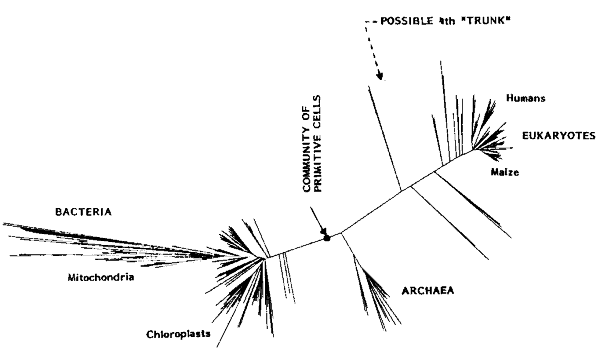 |
Science Frontiers ONLINE No. 128: MAR-APR 2000 |
|
|
"Uprooting the Tree of Life"
"is far more complicated than was believed and may not have had a single root at all."
The article proper relates how the Tree of Life has its own evolutionary history. Twenty years ago, scientists had that single ancestral cell splitting into two main trunks: the prokaryotes (bacteria) and the eukaryotes (every-thing else). More recently, a third trunk has been grafted onto the Tree; namely, the archaea (microorganisms that look like bacteria but possess markedly different genes). The archaea favor extreme environments and, curiously, are more closely related to you and me than are the bacteria.
But according to this article (by W.F. Doolittle), the triple-trunked Tree of Life is simplistic. One reason for this is that genes, once thought to flow only from parent to progeny, are now known to travel laterally. Species barriers are broken. Genes jump from trunk to trunk, from branch to branch, twig to twig. Of course, these jumps are seen primarily among the microorganisms. The real Tree of Life, then, is more like a snarl of vines--a Jungle of Life, a genetic Tower of Babel!
Furthermore, no longer does the multiplicity of life forms spring from a single primordial cell but rather from a "common ancestral community of cells."
Complicating the picture still further, many eukaryote genes are totally unlike those seen in the prokaryotes and archaea. They "seem to come from no-where." "Nowhere" might really be a fourth trunk supporting what is now seen as a confused tangle of vegetation.
(Doolittle, W. Ford; "Uprooting the Tree of Life," Scientific American, 282:90, February 2000.)
Comment. That "ancestral community of cells" could have been formed from more than one (nonsupernatural) creation and/or multiple infusions of life forms and/or biochemical templates conveyed to earth by comets and meteorites. In other words, the Tree of Life may also have had (or still has) extraterrestrial roots, making life truly a cosmic phenomenon.

Other Sites of Interest
|